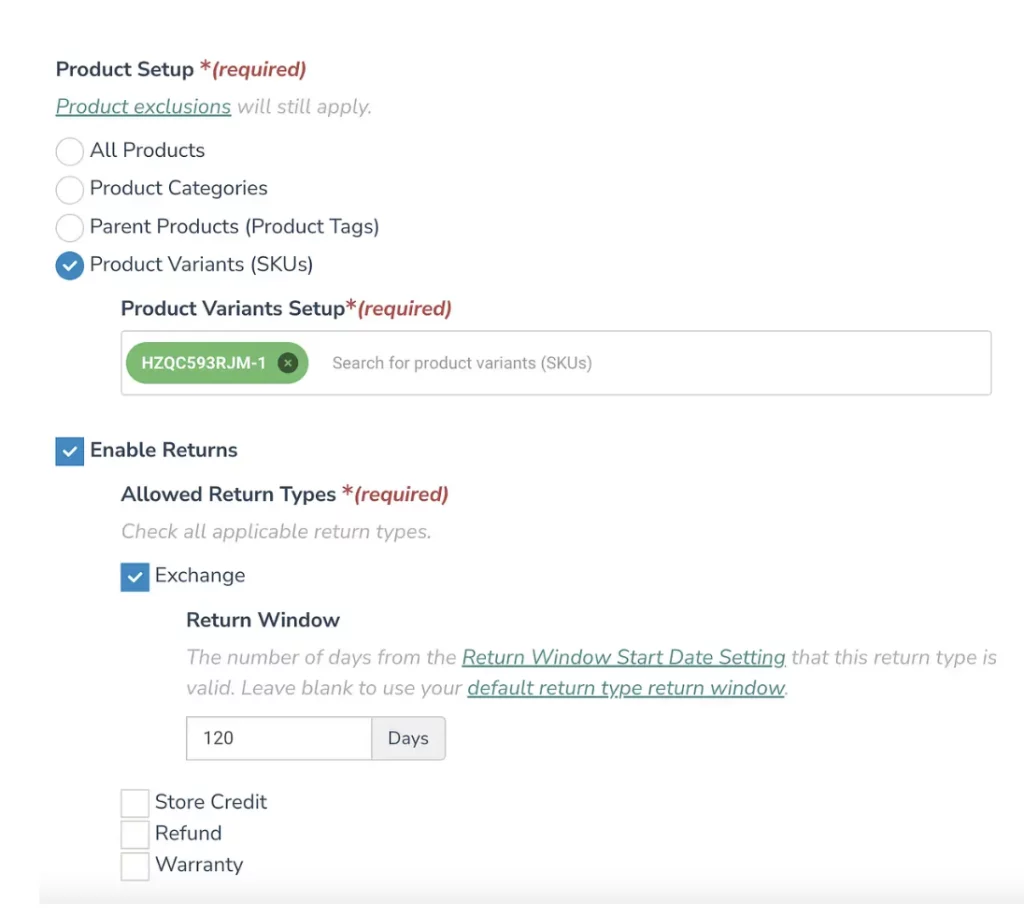Automate Holiday Returns with Multiple Return Policies

The holiday season is fast approaching, and retailers are getting ready to batten down the hatches. While the holidays are an exciting time filled with sales, there’s a byproduct for all these sales – returns.
Holiday returns have been notoriously difficult. Retailers have had to manually keep track of every product included in their holiday return policy and review the order date against the policy for each return.
When retailers are crunched for time during the holidays, every minute adds up, which is why retailers have needed a way to automate holiday return policies.
Now they can.
Introducing Multiple Return Policies, our gift to retailers, just in time for the holiday returns rush.
With Multiple Return Policies, retailers can automate the holiday returns process, customize policies specific to product categories or product rules and protect their profits by ranking and enforcing different policies offered during a special promotion or seasonal sale.
Before we dive into why Multiple Return Policies matter to retailers, let’s review why holiday returns have been difficult.
Why are Holiday Returns Managed Manually?
As mentioned, before Multiple Return Policies, retailers had to manually go in and tag every item they wanted to be included in their holiday policy. Once they finished spending hours tagging each product, they had to check every return against the order date and against their policy.
When retailers are pressed for time during the holidays, the last thing they need is to waste minutes reviewing each return manually.
The time and labor spent by customer support teams manually reviewing and tagging each return is inefficient and eats away at a retailer’s profitability. This causes operational challenges that can lead to shipping delays, customer service bottlenecks, and warehouse chaos.
On top of that, all the manual work can cause employees to get burnt out. Employee turnover during the holiday season becomes another headache. Potential new (or returning) customers are left frustrated with a slow and inconsistent post-purchase experience.

Let’s walk through an example.
Let’s say a retailer normally has a 30-day exchange, store credit, and refund window. They also have a 365-day warranty return window.
During the holidays, this may cause headaches because a shopper may have purchased a gift on Black Friday, but the recipient of the gift won’t receive it until a month later. So the return window may have passed before or on the day the recipient gets their gift.
Now, if the recipient receives their gift and needs to make an exchange, they are out of luck, or the retailer will need to manually check the order date to confirm it was purchased on a date within their “Holiday Policy” and manually create that return.
To make matters worse, this may be the 1st time that the gift recipient was introduced to the retailer’s brand. If the post-purchase experience is poor, they may choose to never buy again.
A repeat customer may become frustrated because of a different post-purchase experience than they’re used to and churn. All the marketing dollars spent on acquiring and retaining a loyal shopper go down the drain.
Luckily, shoppers and retailers don’t have to worry about this scenario again.

Why Should you Automate Holiday Returns?
With Multiple Return Policies, retailers can finally create a specific ‘Holiday Policy’, extending the return window for products based on a start date and an end date.
For example, with Multiple Return Policies, retailers can set up their ‘Holiday Policy’ where the return window for products purchased between Black Friday (November 25th) and Christmas (December 25th) has extended return windows to accommodate gift recipients who don’t receive their items till a later date.
Meaning, any orders, including products in the ‘Holiday Policy’, will NOT need to be manually checked for the date of purchase, and will have extended return windows automatically.
Retailers even have the flexibility to set different return windows per return type in their holiday return policy.
Only want to issue 60 days for a refund, but 90 days for store credit? That’s all possible now with Multiple Return Policies.
However, automation isn’t the only added benefit of Multiple Return Policies.
Flexibility in How Retailers Design and Implement Return Policies
Retailers now can select all their products, product categories (Shopify collections), parent products (product tags), or even product variants (SKU) to be included in holiday return policies.
What does that mean? No more individually tagging products, which means retailers can easily create return policies based on already existing categories or tags in Shopify.
Additionally, retailers can now drill down to the variant level of a product to set up certain exclusions or rules.
For example, if a retailer is discontinuing a certain sweater color or size offered during a holiday sale and doesn’t want to accept returns for that specific color or size, now they can.
To take it a step further, retailers can even create specific return windows for each return type on the policy level.

Automation and customization aren’t the only benefits. There is one final perk retailers can take advantage of – ranking their different policies.
Ranking Multiple Return Policies
Maybe a retailer requires select products to always be final sale UNLESS it’s sold during the holiday season. That is now an option. Multiple Return Policies ranks policies using a drag and drop method, where the policy listed first is the highest-ranking policy.
For example, if a retailer has products that are always final sale EXCEPT if they were purchased between November 25th and February 1st, they can now create a policy that will allow these items to be returnable if they are purchased within the dates of the return policy they created. Once that policy reaches its end date, all orders containing these products will revert back to the final sale return policy.
The opposite is true as well. Suppose retailers have products that are always final sale, and they do not want their ‘Holiday Policy’ to apply to those items. In that case, they can rank their ‘Always Final Sale’ policy above their ‘Holiday Policy’ to make sure those items remain non-returnable even during the holiday season. That way, it will always be enforced first.
The choice is yours.

Remove Stress & Manual Tasks from Returns this Holiday Season
Holiday returns can be a huge headache, but now they don’t need to be. With Multiple Return Policies, retailers can automate their holiday returns process, get more flexibility in how they design and implement return policies, and rank policies however they want.
With their holiday return policy taken care of, retailers can focus their time on improving the customer experience, retention, and lifetime value.
Interested in seeing what the Multiple Return Policies feature looks like in action?
Ready to transform how your team manages returns?
Speak to a returns specialist to see if you’re a good fit!





